Highlights (Key Facts & Solutions)
- Critical Need: Backing up the QuickBooks company file is necessary to retrieve data easily following system errors, malicious intrusion, or when migrating data to a different computer.
- Checking Status: Users should navigate to the File menu, hover over Back Up Company, to instantly check the date and time of the last successful backup.
- QuickBooks Desktop (Windows) Backup Options: The guide provides steps for three methods, all requiring you to Switch to Single-user Mode initially :
- Manual Backup: Select Create Local Backup and choose Save it now.
- Automatic Backup (On Close): Saves a copy automatically to the local Auto Backup folder each time the company file is closed, based on a set frequency.
- Scheduled Unattended Backup: Runs periodically without user intervention, requiring the Windows sign-in password for permission to execute the background task.
- Data Integrity Check: Both manual and automatic backups should include selecting Complete Verification to run a test that ensures the integrity and usability of the backup file before it is saved.
- Mac/Apple Backup: Specific instructions confirm that Mac users access backup settings via QuickBooks > Settings > Backup to set automatic frequency and destination, including options to Encrypt files with a password and back up the attached documents library.
Overview
For any business using QuickBooks, it’s crucial to create backups of your company file consistently. Having a backup of your QuickBooks data is a proactive measure to safeguard your information against unforeseen events that may make the original files unusable.
If the system where QuickBooks is installed encounters any error/problem or malicious intrusion, you can easily retrieve the data from the latest backup, preventing any data loss and inconvenience.
Having a backup of QuickBooks files is also particularly useful if you need to move the data to a different computer.
Note: Before moving on to the how to backup company file, you may want to check when the last backup company file was saved.
To check the last backup time of the company file,
- Step: Navigate to the file menu.
- Step: Hover the cursor over the “Back Up Company” option.
The date and time of the last backup will now be displayed.

How to Backup Company File In QuickBooks Desktop?
Manual Backup Process
You can back up your QuickBooks company file automatically, or you can manually create a backup anytime you want.
To create a backup, manually complete the following steps:
- Step: Launch QuickBooks and navigate to the File menu.
- Step: Choose the option to Switch to Single-user Mode.
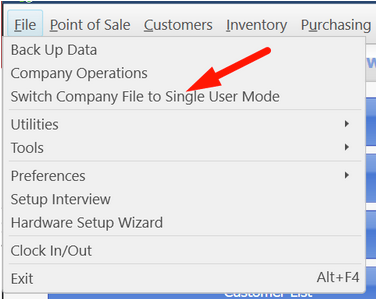
- Step: Hover the course over the Back Up Company option and click on Create Local Backup.
- Step: A window will appear, in which select the Local Backup option followed by clicking on Next.
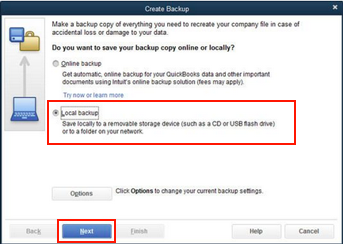
- Step: In the section labeled Local Backup Only, click on Browse and choose the location where you wish to store your backup company file.

- Step: Specify the number of backups to be created. (not mandatory) A test will be launched to ensure the integrity of your backup file before saving.
- Step: After the test is over, click on OK.
- Step: Choose the “Save it now” option and then click on Next.
QuickBooks will then generate the specified number of company file backups. Upon completion, a confirmation message will be displayed.
Automatic Update
QuickBooks offers two automatic backup options for your files. The first option (A) is to generate a backup file each time you close the company file, with the frequency you set. This backup file is stored on your hard drive in the QuickBooks directory, specifically in a folder named “Auto Backup.”
The second option (B) allows you to schedule backups that run without your intervention. This means you don’t need to be using QuickBooks or even be at your computer. This backup file can only be saved on a local or network hard drive, and the company file must be closed during a scheduled backup.
To set up QuickBooks to automatically backup company file complete the following steps:
- Step: Navigate to the File menu and select Switch to Single-user Mode.
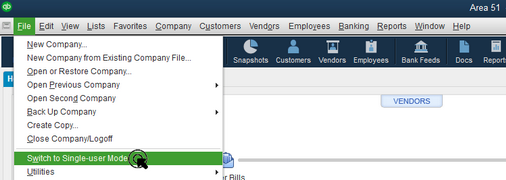
- Step: Hover the course over the Back Up Company option and click on Create Local Backup.
- Step: A window will appear, in which select the Local Backup option and then Next.
- Step: In the Local Backup Only section, click Browse and choose your desired save location for the backup company file.
- Step: Set up the default backup option as required.
- Step: From under the Online and Local Backup section, select Complete Verification. This initiates a test to ensure the integrity of your backup file before saving.
- Step: Click on OK and then Next.
Choose the (A) Save it Now and schedule future backups option or select (B)Only schedule future backups.
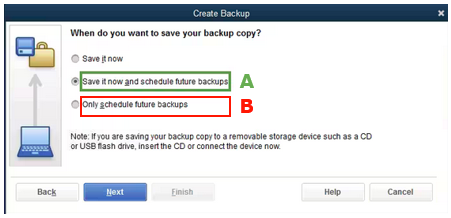
(A). Automatically Backup When Closing Company File
- Step (A): Choose the (A) Save it Now and schedule future backups option, and click Next.
- Step (A): From under the BACK UP AUTOMATICALLY section, check the box for Save backup copy automatically when I close my company file and specify the number of times between backups.

- Step (A): Very the inputs and click on Finish to complete the process.
QuickBooks now will create a backup and schedule your future backups simultaneously. Upon completion, a confirmation message will be displayed
(B). Schedule a Periodic Automatic Backup
- Step 8(B): Choose the (B) Only schedule future backups option, and click Next.
- Step 9(B): To set a schedule, click New. Fill in the data fields to establish a backup schedule. You can specify a particular time or day of the week.
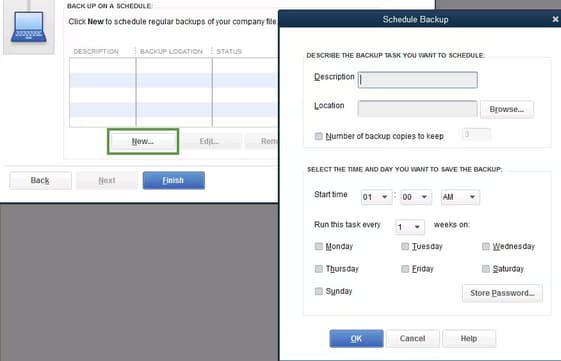
- Step(B): After setting your schedule, click OK. QuickBooks will prompt you to enter your Windows sign-in password, granting QuickBooks permission to execute the scheduled backup.
- Step(B): Verify the inputs and click Finish to complete the process. QuickBooks will now schedule your future backups as configured.
How to Backup QuickBooks Company File on Mac/Apple Devices?
Manual Backup Process
Complete the following steps to manually create a backup of your company file on a Mac device:
- Step: Launch QuickBooks,
- Step: Navigate to File and choose the Back Up option.
- Step: Choose the location where you want to save your backup.
- Step: Click on Start Backup.
You will see a confirmation on your screen when the backup is complete.
Scheduling Automatic Backups
Complete the following steps to schedule automatic backups of your company file:
- Step: Launch QuickBooks and select the Settings option.
- Step: Choose the Backup option.
- Step: Choose backup preferences as required. You will see the below backup option on your screen:
- This implies that only your latest backup will be stored. Password-protect files: If you want your backups to be password-protected, select Change and input a password. Backup library of attached documents: Decide if you want to back up attachments that you’ve linked to QuickBooks records and transactions.
- Automatically back up company files every x hours: Decide the frequency with which QuickBooks should back up your business file within a day(every 24 hours).
- Automatically back up company files when closing: Decide if you want your files to be backed up when you exit QuickBooks.
- Save backup files in: Decide the location where QuickBooks should store your backup files. It’s recommended to use a separate drive or computer and save it locally, ensuring you can access your backup if needed.
- Overwrite last backup: Decide if you want QuickBooks to replace your previous backup file.
- Encrypt files with password: If you want your backups to be password protected, select Change and input a password.
- Back up attached documents library: Decide if you want to back up attachments that you’ve linked to QuickBooks records and transactions.
- This implies that only your latest backup will be stored. Password-protect files: If you want your backups to be password-protected, select Change and input a password. Backup library of attached documents: Decide if you want to back up attachments that you’ve linked to QuickBooks records and transactions.
- Step: Once you have chosen and verified the required insults, save the changes.
- Step: Now close the QuickBooks Backup settings window to exit and complete the process.
Conclusion
Backing up your QuickBooks corporation file is essential to guarantee the security and integrity of your financial data. Whether you select manual backups, automated updates, or scheduling periodic backups, QuickBooks delivers diverse options to suit your corporation’s needs. Recurring backups safeguard your corporation file from unanticipated errors, data corruption, or security breaches.
FAQs!
What is the difference between a Local Backup and the QuickBooks Auto Backup folder?
A QuickBooks Local Backup and the Auto Backup folder represent two different methods of data protection:
- Local Backup (
.qbbfile): This is a complete, compressed, and restorable copy of your company file. You manually create it or schedule it to be created to a location of your choosing, such as an external hard drive, USB, or a specific network folder. This is the file you would use for system migration or disaster recovery. - Auto Backup Folder: This folder is a feature-specific location, typically found within your QuickBooks installation directory on your hard drive (e.g.,
C:\Users\Public\Public Documents\Intuit\QuickBooks\Company Files). It stores incremental backup copies generated automatically when you close the company file, based on the frequency you set in your preferences. While useful, since it resides on the same hard drive as the original.qbwfile, it does not protect against a total hard drive failure.
How often should I backup my QuickBooks Company File and where should I store the copies?
The required frequency depends entirely on the volume of daily transactions and risk tolerance, but industry experts recommend a strategy that meets the 3-2-1 backup rule for comprehensive protection.
- Frequency: Users should schedule backups daily or at least weekly, depending on transaction volume. QuickBooks Desktop allows you to set automatic scheduled backups to run unattended.
- Storage (3-2-1 Rule): This rule ensures redundancy:
- Three copies of your data (the original file and two backups).
- On two different types of media (e.g., your local hard drive and an external USB drive).
- With one copy stored off-site (e.g., a secured cloud service or Intuit Data Protect).
I receive an error when trying to switch to Single-user Mode. What should I do?
The inability to switch to Single-user Mode almost always indicates that another user is still logged into the company file, or the QuickBooks Database Server Manager is not properly hosting the file. To resolve the most common cause:
- Ask all other users to completely log out of the company file.
- In the File menu, select Utilities.
- Choose Switch to Multi-user Mode. (This seemingly counterintuitive step helps refresh the file’s status).
- Immediately go back to the File menu and select Switch to Single-user Mode.
If the error persists, use the QuickBooks Tool Hub to run the QuickBooks File Doctor, which diagnoses and fixes multi-user and network access issues.
What is the difference between a QuickBooks Backup file (.qbb) and a Portable Company file (.qbm)?
These two files are compressed copies of your data but serve distinct operational purposes:
- QuickBooks Backup File (
.qbb): The definitive, full-integrity data recovery file. It includes all your transaction data, lists, templates, links to documents, and memorized transactions. It is designed solely for restoring your company file back to a working state. - Portable Company File (
.qbm): A highly compressed, smaller version of the company file, primarily used for easy transfer, such as emailing to an accountant. Crucially, it excludes key components like attached documents, logos, and template files. It should not be relied upon as a full, primary disaster recovery backup.
Why do I need to enter my Windows sign-in password for a scheduled backup?
When you configure a periodic, unattended scheduled backup, you are instructing QuickBooks to execute a task using the Windows Task Scheduler at a specified time, even if you are not actively using the computer.
The operating system requires the application to run under the security context of a valid Windows user. Entering your Windows sign-in password grants the necessary permissions to the Task Scheduler process, allowing it to:
- Access the company file location.
- Access the backup destination folder.
- Run the application in the background when the user’s desktop session may be locked or logged off.
Can I save my QuickBooks Backup file directly to a cloud-synced folder like Google Drive or OneDrive?
Technically, you can save the file to a synced folder, but Intuit does not recommend directly saving or operating a QuickBooks Desktop company file (.qbw) or its backup (.qbb) within real-time, cloud-synced folders like Google Drive, Dropbox, or OneDrive.
- Risk of Corruption: Real-time syncing services can interfere with QuickBooks’ ability to read and write data consistently, particularly during the high-demand creation of a large
.qbbfile. This can lead to data file corruption. - Recommended Method: Save the backup locally first (to your desktop or a non-synced drive). Once the file creation is complete and closed by QuickBooks, manually copy or use a dedicated tool (like Intuit Data Protect or a third-party service) to move the final
.qbbfile to your cloud storage for off-site redundancy.
What steps should I take if the backup verification test fails after creation?
If the verification test fails, the newly created .qbb file is unusable for restoration and must be discarded. The problem lies with data damage in the original company file.
- Run Verify Data: In QuickBooks, go to File > Utilities > Verify Data. This scans the original file for errors.
- Run Rebuild Data: If the verification reveals any damage, go to File > Utilities > Rebuild Data. This process attempts to self-correct internal data corruption. QuickBooks will require a backup before this step, so ensure you have a previous, verified backup to restore from if the rebuild fails.
- Run Verify Again: After the rebuild completes, run the Verify Data tool one more time.
- Create New Backup: If the second verification test comes back clean, attempt to create a new local backup with verification enabled. If the problem persists, search the
qbwin.logfile for the specific error code and contact Intuit support.
Disclaimer: The information outlined above for “How to Backup QuickBooks Company File? – (Manually/Automatically/Schedule an Unattended Backup)” is applicable to all supported versions, including QuickBooks Desktop Pro, Premier, Accountant, and Enterprise. It is designed to work with operating systems such as Windows 7, 10, and 11, as well as macOS.
